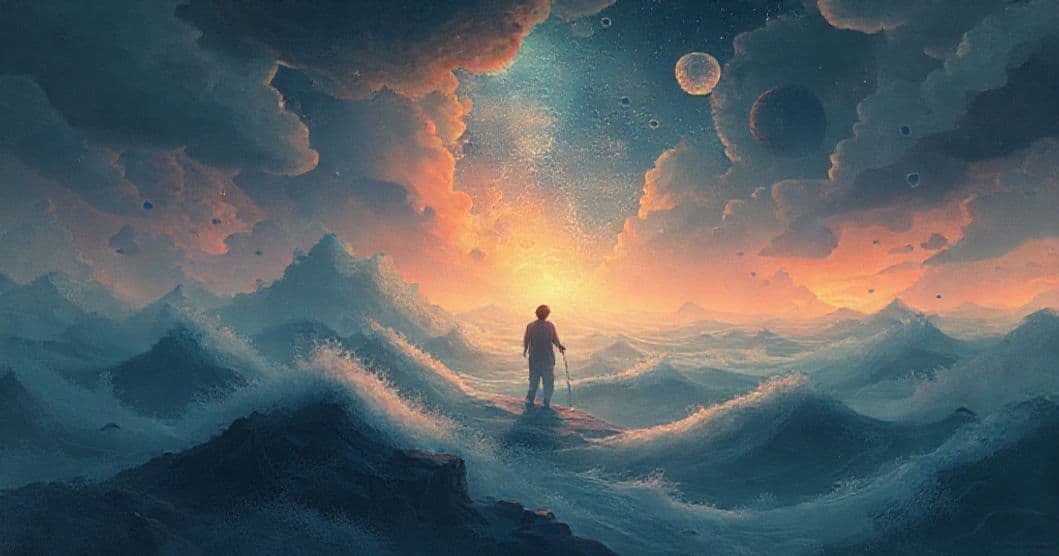Part 1: Dream Presentation
Dreams often unfold as surreal landscapes where the rules of waking reality dissolve, revealing our deepest psychological currents. This particular dream materializes as a journey through conflicting elements: the calm yet vast expanse of the sea, the incongruous mountain road with distant cars, and a creature that transforms from wild primal form to vulnerable human-like visage. As the dreamer navigates this liminal space between water and land, they encounter both struggle and unexpected connection, offering profound insights into the interplay between unconscious forces and waking life.
I awoke in a vast expanse of water, miles from any visible shoreline, yet the sun blazed overhead in a cloudless sky. The sea, surprisingly calm despite its distance from land, reached only to my knees, creating an odd sensation of floating while standing. To my right, a winding mountain road climbed upward, its asphalt glinting in the sunlight as cars moved like tiny beetles along its edge—an incongruous sight, as if I’d stumbled into a dream where both water and road existed simultaneously. I clutched a long, sturdy pole, approximately five meters in length, its weight grounding me in this surreal landscape. At the very top, a creature clung desperately—a gorilla-like form, its fur matted with saltwater, arms wrapped tightly around the pole as if it feared slipping into the depths. A primal urgency filled me: I needed to reach the shore, to balance the pole so neither the creature nor I would fall, to guide us both to safety. Each step forward required careful coordination. The water sloshed around my legs, and as I shifted my weight, the pole wobbled. Twice, I lost my balance, and the gorilla plummeted into the sea with a startled scream—a sound that pierced the calm, echoing with both fear and primal rage. Each time, I’d plunge the pole downward, grabbing its fur and hauling it back to the surface, where it would cling again, soaking wet and panting, until I steadied myself. Finally, the shoreline appeared—a narrow strip of damp sand where the water receded completely. As I stepped onto solid ground, the creature released its grip on the pole and stood, its fur dripping. It reached up and removed a strange, rubbery mask, revealing a face I’d never seen before: wrinkled, red, and deeply lined, like an elderly man’s skin stretched taut. The transformation was unsettling yet strangely familiar. At that moment, my friends appeared—three figures I recognized from waking life, standing at the edge of the beach, smiling. The creature turned toward them, and without hesitation, it leaned in and kissed each of them on the cheek, their laughter mingling with the sound of the waves.
Part 2: Clinical Analysis
Want a More Personalized Interpretation?
Get your own AI-powered dream analysis tailored specifically to your dream
🔮Try Dream Analysis FreeSymbolic Landscape: Navigating the Unconscious
The dream’s symbolic elements form a cohesive narrative of internal conflict and integration. The sea represents the unconscious mind—an expanse of depth, emotion, and unknown territory that the dreamer must traverse. Its calm surface belies the potential turbulence beneath, mirroring how repressed emotions often lie dormant until triggered by life events. The mountain road, with cars driving along its edge, introduces the external world’s demands and the pressure of societal expectations, creating tension between the dreamer’s internal journey and external responsibilities.
The five-meter pole emerges as a critical symbol of control and support. Its length suggests the dreamer’s attempt to maintain order across a vast, unstable landscape, while its role as a lifeline for the gorilla indicates a paradox: the need to protect something primal while remaining anchored to reality. The recurring act of dropping and retrieving the gorilla embodies the dreamer’s struggle to balance control with surrender—an essential psychological dynamic where letting go temporarily feels dangerous but ultimately necessary for progress.
The gorilla itself functions as a multifaceted archetype. In Jungian psychology, primates often represent the shadow self—the repressed, untamed aspects of personality. Its clinging to the pole suggests the shadow’s resistance to integration, while the subsequent removal of the mask reveals a deeper layer: the
